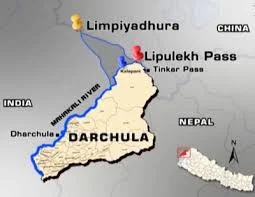Introduction
India and Nepal have been sharing a fairly cordial relationship all along, primarily because of close cultural and ethnic ties. In fact nearly 4000 troops of the Gorkha Regiment, which is the pride of Indian Army, hail from Nepal.
India is Nepal’s largest trading partner. Nepal being a land locked country, is largely dependent on India for essential commodities; especially petrol is almost completely sourced by Nepal from India.
The border between these two countries is largely open for movement of people and goods, which quite significantly contributes to the GDP and economic growth of both countries.
India also looks at Nepal as the world’s largest unharnessed reserviour of hydro-electric energy source. Besides, Nepal is a buffer state between India and China and provides India with an inherent protection against the aggressive designs of China.
Reasons for Public Anger against India in Nepal
The present Communist Party of Nepal came into power under the Prime Minister-ship of Mr KP Sharma Oli in 2015. The ideological affinity of the Party naturally drew the ruling dispensation towards China.
A new Constitution of Nepal was adopted the same year, which did not adequately cater to the aspirations of the ethnic minorities, mainly ‘Madhesis’ living in Nepal. Resultantly, the Madhesis rejected the Constitution and demanded its amendment so that their rights and aspirations were adequately addressed.
There agitations turned violent, lot of public property was destroyed and the Madhesis blocked the main artery that connects India with Nepal. Thus, disrupting the movement of essential goods, especially petrol and construction material that was essentially required to rebuilt Nepal, which had been devastated by a major earthquake that hit the country the same year.
Incidentally, the Madhesis share strong ethnic ties with the adjoining terai region of Bihar in India. Considering this fact, the people of Nepal widely believed that India was behind the Madhesis violence and conjectured that India wanted to oust the pro-China Communist Party by creating instability in Nepal.
Hence, a hash tag movement called #backoffIndia became popular in Nepal. Taking advantage of the deteriorating India-Nepal relations, China moved in to provide petrol and other important essential commodities to Nepal during this period of road blockade and have ever since been making efforts to replace Nepal’s dependence on India.
Again in 2015, when there was a thaw in India and China relations, the Lepulekh Agreement was signed between the two countries. As per this agreement the Lepulekh pass was opened between India and the China controlled, Tibet Autonomous Region (TAR).
The idea was to promote trade and commerce between the two countries, as also, it was seen as a goodwill gesture by China to reduce the distance for the pilgrims trekking from India to Kailash Mansorovar that falls in Tibet. Earlier, the route was through the Nathula Pass in Sikkim. The route was much longer and at least 80% of the trek was through Chinese territory. On the contrary, movement through the Lepulekh approach was much shorter and only 16% in Chinese territory.
However, while signing this agreement, neither China nor India consulted Nepal, who has for long claimed this territory to be disputed. Hence, this further antagonised and inappropriately coloured the public perception in Nepal.
Indo-Nepal Border Issues
The border issue between India and Nepal has been simmering for many years now. However, it came to the fore recently when India published fresh political maps of India in November 2019, which had got necessitated because of abrogation of Article 370 and creation of Union Territories of Jammu and Kashmir and Ladakh.
These maps show 400 square km of territory that Nepal claims to be its territory under wrongful possession of India. This piece of real estate extends from the eastern most tip of Pithoragarh in Uttara Khand and is bounded by China to the North and Nepal to its East and South.
The India-Nepal boundary was delineated after the Anglo-Nepalese war that lasted for two years from 1814 to 1816. The Treaty of Sagauli was signed between the Gorkha ruler of Nepal and the British East India Company in 1816.
The Treaty, which is still acceptable till this date, denoted the Kali River (also called Mahakali) as the border between India and Nepal. All territory to the East of the River is Nepal and India is to the West of this River.
However, the contentious issue is the interpretation of the exact point of origin of River Kali. India claims that the River originates from Kalapani and that tri-junction is from where Nepal’s border starts. While, Nepal claims that the River originates much higher in the mountains from a place called Limpiyadhura and all territory to the East of the River from that point onwards, held by India for the previous 60 years, belongs to Nepal.
Latest Development in the Border Dispute
The border issue shot into prominence recently, when Indian Defence Minister Rajnath Singh virtually inaugurated an 80km stretch of new road from Dharchukla to Lepulekh pass.
This road that runs along the Chinese border is of great military importance to India as it will speed up the mobilization of troops and military hardware to the strategically sensitive Lepulekh pass. This pass is the shortage distance from China to the Indian capital city and hence, is vulnerability for India that needs to be properly secured and adequately guarded.
The idea of inauguration of this road by the Defence Minister was to send an assertive signal to China during the ongoing Ladakh standoff. However, it was ill-timed for India because of the internal political turmoil happening in Nepal. The Nepalese Prime Minister KP Sharma Oli, who was facing the heat from the opposition over certain decisions that the ruling government had taken and also his position within the Communist Party, was fast becoming untenable.
The inauguration of the road to Lepulekh that passes through 17km of territory claimed by Nepal as disputed came as a God-given gift to PM Oli and he was able to suitably divert attention of the political parties as well as ginger-up nationalist sentiments in the country towards the border issue.
In a very recent development, the Nepalese Parliament cutting across party lines made a constitutional amendment to revise the maps of Nepal to include the territories of Limpiyadhura, Kalapani and Lepulekh. Thus, this action has left no scope for any diplomatic intervention or dialogue with India on the border issue.
Conclusion
The above said entire development benefits China to forge better ties with Nepal and wean it away from India. China, with its deep pockets has been investing in a major way in infrastructure development and providing financial aid and loans to Nepal.
Nepal happens to be an important waypoint in the Belt and Road Initiative of China. Today, the road and rail connectivity of China to Nepal is much better that of India. In fact it was in news yesterday that Mandarin will be made compulsory in Nepalese schools. You can well imagine with what speed Nepal is drifting towards China.
It is cardinal for India’s economic and politico-military interests that Nepal remains a friendly country with India, especially when the dragon is flexing its muscles from every inter-state border that India shares in the subcontinent. Hence, India will have to take suitable diplomatic measures to ensure that it brings back Nepal into its folds before it is too late.




